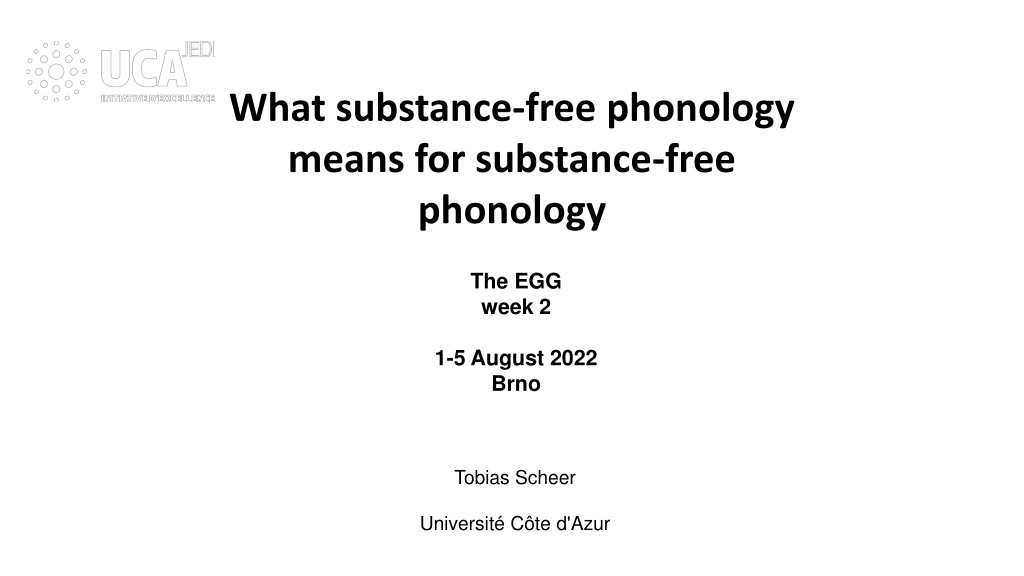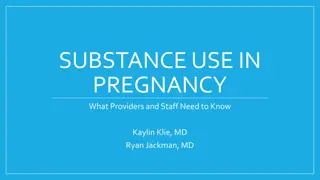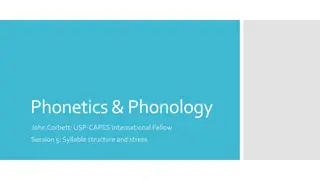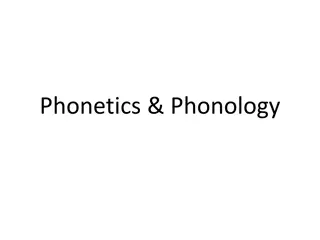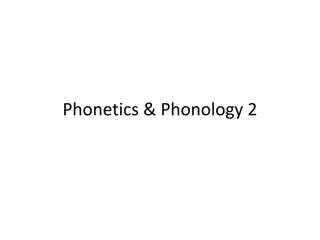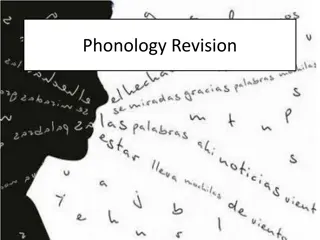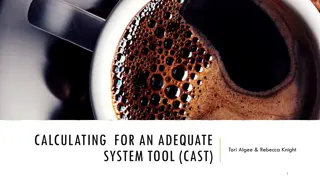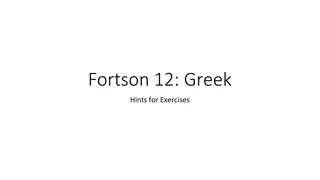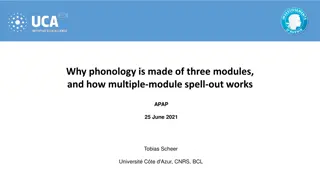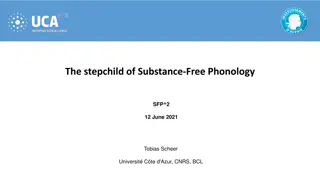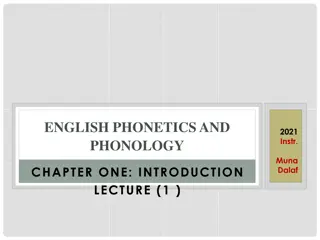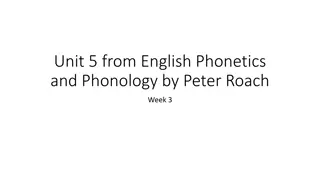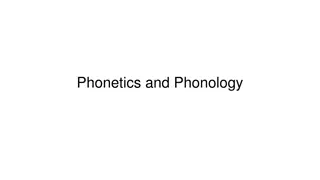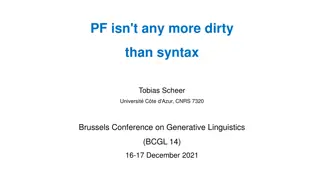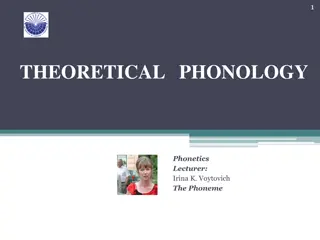Understanding Substance-Free Phonology and Its Implications
Substance-free phonology, as discussed by Tobias Scheer, explores the distinction between phonologically meaningful and meaningless items, highlighting their production and phonetic correlates. The article emphasizes the non-arbitrary nature of meaningful items and the arbitrary interchangeability of meaningless items, shedding light on the stable cross-linguistic properties in phonological theory.
Download Presentation

Please find below an Image/Link to download the presentation.
The content on the website is provided AS IS for your information and personal use only. It may not be sold, licensed, or shared on other websites without obtaining consent from the author. Download presentation by click this link. If you encounter any issues during the download, it is possible that the publisher has removed the file from their server.
E N D
Presentation Transcript
What substance-free phonology means for substance-free phonology The EGG week 2 1-5 August 2022 Brno Tobias Scheer Universit C te d'Azur
5. Phonologically meaningful (Son) vs. meaningless (Place, Lar) items
phonologically meaningful vs. meaningless items production phonology | R | N | x | | R | N | x | | Son Phon I: items 1. are not interchangeable = meaningful 2. hence non-arbitrary 3. have no phonetic correlate O | x | | C | x | O | x | | Place, Lar Phon II: items 1. are interchangeable = meaningless 2. hence arbitrary 3. have a phonetic correlate Spell-out of Phon II items [a] [b] [c] [d] [e] Phonetics
meaningful vs. meaningless items phonetic correlates only items below the skeleton are spelt out = have a phonetic correlate Clements, George 2009. Does Sonority Have a Phonetic Basis? Contemporary views on architecture and representations in phonological theory, edited by Eric Raimy & Charles Cairns, 165-175. Cambridge, Mass.: MIT Press. labiality, backness etc. but there is nothing like Nucleus palatality this also holds for Concordia
meaningful vs. meaningless items Scheer, Tobias 2022. 3xPhonology. The Canadian Journal of Linguistics. Place and Lar primes are arbitrary = interchangeable phonologically meaningless [labial] is just as good as [labial] and are arbitrary and interchangeable symbols Son primes and the structure they build are not arbitrary = not interchangeable items above the skeleton belong to a closed class in all languages: onset, nucleus, ictus, grid mark, foot, prosodic word, etc. phonologically meaningful they are not interchangeable: you can't replace an onset by a nucleus, a foot by a coda, etc. this also holds for Concordia
meaningful vs. meaningless items stable cross-linguistic properties nuclei host vowels, not consonants rhymes form a unit with the onset preceding, not following them etc. alphas and betas have no cross-linguistically stable properties this also holds for Concordia what is cross-linguistically stable is the association of itself has no cross-linguistically stable property itself has no clue that it is associated to a phonetic category labiality
meaningful vs. meaningless items inventories despite substantial effort, phonologists have never been able to establish a putative universal set of primes (specifically: features). but the inventory of items at and above the skeleton is trivial and undisputed (within a given theory: moras, onset, nuclei etc.) phonologically meaningless vs. meaningful this may be indicative of the fact that there is no such inventory for features, while there is one for items at and above the skeleton
6.1. Place & Lar primes are emergent Son primes are not
innateness of primes Clements, George 2009. Does sonority have a phonetic basis? Contemporary views on architecture and representations in phonological theory, edited by Eric Raimy & Charles Cairns, 165-175. Cambridge, Mass.: MIT Press. an issue never brought up because it seems trivial: how does the child know that vowels go into nuclei, and consonants into onsets/codas? why are there no flip-flop systems where phonetic vowels are in onsets/codas and phonetic consonants in nuclei? Son primes cannot be emergent if primes are emergent, any association between a phonological and a phonetic category is possible: phonetic arbitrariness [x] thus, if spell-out relations of Son primes were arbitrary, phonetic vowels could be associated to phonological consonants and then be syllabified as onsets/codas phonetic consonants could be associated to phonological vowels and then be syllabified as nuclei
innateness of primes Berent, Iris 2013. The Phonological Mind. Cambridge: CUP. Berent, Iris, Tracy Lennertz, Jongho Jun, Miguel A. Moreno & Paul Smolensky 2008. Language universals in human brains. Proceedings of the National Academy of Sciences of the United States of America 105: 5321 5325. phonology spell-out phonetics [x] [y] [z] items innate? yes no associations innate? yes no Son Place, Lar the work by Iris Berent supports the universal and innate character of sonority sonority sequencing is a grammatical universal since it cannot be derived from extra-grammatical factors (such as phonetics) it is active in structures that are unattested in the speaker's language, such as branching onset preferences produced by Korean speakers, whose language lacks branching onsets.
6.2. Son primes are not interchangeable
Son primes Scheer, Tobias 2022. 3xPhonology. The Canadian Journal of Linguistics. [repeated from above] Place and Lar primes are arbitrary = interchangeable phonologically meaningless [labial] is just as good as [labial] and are arbitrary and interchangeable symbols Son primes and the structure they build are not arbitrary = not interchangeable items above the skeleton belong to a closed class in all languages: onset, nucleus, ictus, grid mark, foot, prosodic word, etc. phonologically meaningful they are not interchangeable: you can't replace an onset by a nucleus, a foot by a coda, etc.
6.3. Son computation is not arbitrary
Son computation since Place & Lar primes are arbitrary and interchangeable, their computation is arbitrary. Hale, Mark & Charles Reiss 2008. The Phonological Enterprise. Oxford: OUP. any segment can be turned into any other segment in any context and its reverse. Chabot, Alex 2019. What's wrong with being a rhotic? Glossa 4: article 38. Chabot, Alex 2021. Possible and impossible languages. Naturalness, third factors, and substance-free phonology in the light of crazy rules. Ph.D dissertation, Universit C te d'Azur. therefore, phonology is not natural phonetic naturalness cannot even be calculated since there is nothing phonetic in phonology in the first place. Bach, Emmon & R. T. Harms 1972. How do languages get crazy rules? Linguistic change and generative theory, edited by Robert Stockwell & Ronald Macaulay, 1-21. Bloomington: Indiana University Press. support: crazy rules = that make no sense phonetically speaking l / V__V Sardinian
Son computation Scheer, Tobias 2015. How diachronic is synchronic grammar? Crazy rules, regularity and naturalness. The Oxford Handbook of Historical Phonology, edited by Patrick Honeybone & Joseph C. Salmons, 313-336. Oxford: OUP. Chabot, Alex 2021. Possible and impossible languages. Naturalness, third factors, and substance-free phonology in the light of crazy rules. Ph.D dissertation, Universit C te d'Azur. crazy rules are only ever segmentally crazy computation concerning items above the skeleton is never crazy there is no compensatory shortening there is no tonic shortening there is no closed syllable lengthening there is no anti-Latin stress (stress the antipenultimate except if the penultimate is short, in which case stress the penultimate) isn't that a mere sample issue? maybe there are crazy syllabic rules out there that we have missed. NO. Given a random sample where segmentally and syllabically crazy rules are equally represented, there is no reason this sample contains no syllabically crazy rules.
6.4. Summary
summary Son is different items are phonologically meaningful computation is not arbitrary (no crazy rules) items are not arbitrary: not interchangeable mapping is not arbitrary: phonetic vowels are always in nuclei have no phonetic correlate | R | N | x | | R | N | x | | Son O | x | | C | x | O | x | | items are phonologically meaningless computation is arbitrary (crazy rules) items are arbitrary: interchangeable mapping is arbitrary: can map to anything and its reverse have a phonetic correlate (labiality etc.) Place & Lar
summary in terms of visibility Place cannot bear on Son but Son bears on Son Lar cannot bear on Son Visibility table (Son-Place-Lar) syllabification, infixation, stress assignment, lenition (intervocalic spirantization), etc. Son bears on Son yes Son Son Lar Lar Place Son *C is syllabified in a branching onset but only when voiced * infix lands after the first voiced C no Lar Lar Place Place Lar Son * C is syllabified in a branching onset but only when labial * infix lands after the first labial C no Place Place Lar Place
7. What kind of animal is sonority?
what kind of animal is Son? if sonority is the same in all languages hard-wired = innate it must have a phonetic correlate children must be equipped at birth to detect this correlate
what kind of animal is Son? Fletcher (1972 [1929]: 82ff) Heffner (1950: 74) Bloch & Trager (1942: 22) Price (1980) Ohala (1992) Wright (2004: 39f) Harris (2006) Clements (2009) Parker (2008, 2011) Gordon et al. (2012) Bakst & Katz (2014) what is this phonetic correlate? perceptual salience, owing to phonetic properties such as loudness, energy and intensity sonority = perceptual salience predates language in humans other species have it: the carrier signal it was inherited by the human species Place & Lar are not inherited, they are human innovations.
Ohala, John 1992. Alternatives to the sonority hierarchy for explaining segmental sequential constraints. Papers from the Parasession on the Syllable, Chicago Linguistic Society, 319- 338. Chicago: Chicago Linguistic Society. Harris, John 2006. The phonology of being understood: further arguments against sonority. Lingua 116: 1483-1494. what kind of animal is Son? two interesting observations Son is composite: loudness, energy and intensity "sonority does not map to any unitary physical property but is rather a cover term for a collection of independent acoustic properties that contribute to an overall dimension of perceptibility or auditory-perceptual salience." Harris (2006: 1486), also Ohala (1992: 325) entropy counts modulations (modifications of the signal) count, rather than static values. Harris (2006), Ohala (1992: 325)
Stilp, Christian E. & Keith R. Kluender 2010. Cochlea-scaled entropy, not consonants, vowels, or time, best predicts speech intelligibility. PNAS 107: 12387-12392. what kind of animal is Son? universal sonority may be a "natural consequence[s] of operating characteristics of the mammalian auditory system." (Stilp & Kluender 2010: 12390b) entropy Shannon's (1948) information theory the degree of informativeness of an event depends on its entropy, i.e. the uncertainty or unpredictability associated with it the more unexpected, the more informative.
what kind of animal is Son? Stilp, Christian E. & Keith R. Kluender 2010. Cochlea-scaled entropy, not consonants, vowels, or time, best predicts speech intelligibility. PNAS 107: 12387-12392. Cochlea-scaled Spectral Entropy (CSE) "a measure of the relative (un)predictability of signals that is operationalized as the extent to which successive spectral slices differ (or cannot be predicted) from preceding spectral slices. Most simply, CSE is quantified as Euclidean distances between equivalent-rectangular-bandwidth-scaled spectra of fixed-duration (16 ms) sentence slices that were processed by auditory filters" (p. 12388a) "[t]his pattern of CSE decreasing from low vowels, to high vowels, to laterals/glides and nasals, to fricatives, to affricates, and finally stops closely parallels the sonority hierarchy" (p. 12389a) purely acoustic: "there are no assumptions that the signal is created by a vocal tract" (p. 12390b) no introduction of constructs such as distinctive features or any property of linguistic theory
Stilp, Christian E. & Keith R. Kluender 2010. Cochlea-scaled entropy, not consonants, vowels, or time, best predicts speech intelligibility. PNAS 107: 12387-12392. what kind of animal is Son? universal sonority may be a "natural consequence[s] of operating characteristics of the mammalian auditory system." (Stilp & Kluender 2010: 12390b) thus maybe there is no need for phonetic Son correlates to be innate the child gets that for free from the mammalian auditory system. but what still needs to be innate is the information that cognitive categories will be built based on the phonetic correlate / Cochlea-scaled Spectral Entropy.
what kind of animal is Son? what children know at birth there are three computational systems (modules): Son, Place, Lar their wiring: what other systems they receive information from, what other systems they are sending information to. their domain of competence (domain specificity): Son takes only Son primes, Lar only Lar primes, Place only Place primes for each system, the algorithm that runs: Son produces syllable structure, etc. each system is to be populated with cognitive categories: Lar / Place primes are constructed based on environmental information (emergent) Son primes may as well be constructed this way, see Stilp & Kluender.
8. Place and Lar are waterproof
Place & Lar are waterproof Scheer, Tobias 2022. 3xPhonology. The Canadian Journal of Linguistics. Place and Lar computation appear to be mutually waterproof but Lar can bear on Lar Lar cannot bear on Place and Place can bear on Place Place cannot bear on Lar Visibility table (Son-Place-Lar) Son bears on Son yes syllabification, infixation, stress assignment, lenition (intervocalic spirantization), etc. Son Son Lar Lar Place Son no *C is syllabified in a branching onset but only when voiced * infix lands after the first voiced C *velars palatalize but only when voiced voice assimilation Lar Lar Place Place Lar Son no yes no * C is syllabified in a branching onset but only when labial * infix lands after the first labial C *C undergoes voice assimilation, but only if labial velars palatalize before front vowels no Place Place Lar Place yes
